

How to create a decentralized cloud storage system and how to use it is one of the most repeated questions. Let’s get the answer today!
The contemporary business sector is seeing a rapid rise in decentralized cloud storage. Participants in a decentralized cloud storage system may store data on various computers or servers hosted by people taking part. P2P cloud storage is a decentralized cloud storage system. To ensure the security of your data, this cloud service makes use of blockchain and cryptography.
A network of computers distributes data, making it more accessible and cost-effective. Anyone may become a member of a decentralized cloud storage network. Bitcoin may be made by sharing free hard drive space, which is exciting.
Is It Essential to Have a Decentralized Cloud Storage Network?
The following requirements must be fulfilled for decentralized cloud storage:
- Decentralized cloud storage networks are necessary to guarantee that no one organization controls the whole platform.
- Customer service will be subpar if a single entity controls the whole network.
- Users should have the option of removing their data from their PCs and re-creating it to feel secure with the service.
- No one except the user of the service should see their data. The providers are unable to see it. Because of this, customers can be sure that their private information is safe and secure at all times.
- Customers should take into account the cost of the goods. Amazon’s $23-per-month membership fee makes little sense regarding how inexpensive storage has become.
- Storage providers and customers must be rewarded for maintaining the system.
- In the cloud, you may rent out your hard drive space to other people for a price. Individuals who want to save their data online should pay for this service. Isn’t it obvious?
A decentralized storage solution delivers better data protection and security with no single point of failure, even if suppliers cannot promise rock-bottom pricing. Paying fees and using the finest service providers are the best ways to find the best service providers. However, low-quality service providers will face the consequences of quickly losing clients.
On the other hand, decentralized storage employs a network of computers, or nodes, to store data instead of a single server. Decentralized P2P networks link all of these nodes. Napster and BitTorrent were the first P2P networks.
The Integrity of Data Stored On a Decentralized Platform
It is possible to upload and download files in a decentralized storage system in the same way they were uploaded and downloaded in a centralized storage system.
P2P networks may be used to download file fragments from a decentralized storage system to complete the download of the whole file. This, too, operates like BitTorrent. Due to the default encryption level of your files, nodes in a distributed storage system cannot access or edit them. As a consequence, your information is safe and secure.
Decentralized storage systems do not depend on a single place to store data. Because peer-to-peer storage is used rather than servers, decentralized storage speeds up data transport.
It is possible to verify the integrity of data stored on a decentralized platform using encryption and a blockchain. There is less trust in a single, centrally managed body as a consequence.
How to Create a Decentralized Cloud Storage?
Creating a decentralized cloud storage network from scratch is very time-consuming and challenging. To work with Storj, developers who are unfamiliar with the platform and its APIs will need a high degree of programming skill. If your team does not have this knowledge, they will require outside help.
With this broad range of talents, the development team must design and construct a user interface for Service Providers and growers. We need UI/UX, networking, encryption, database administration, blockchain distributed apps (DApps), and smart contracts to build the decentralized framework to monitor decentralized storage solutions.
When hand-coding, developers must perform the following:

Create CLI-integrated user interfaces for users. Users may download and save data on their computers thanks to a P2P network that the tenants have set up. To decrypt this file, you need the private key given by the renter. The system should have a backup plan: P2P networks must have enough redundancy since certain users may be unreliable. In a P2P network, “simple replication” and “erasure coding” may be employed to create redundancy. This will replicate many copies among agricultural nodes using the basic replication approach.
Due to this technology’s complexity and cost, it is not easy to implement. The developers must consider numerous alternatives. Such as conserving the number of files in the shard set and ensuring that shard sizes are constant while implementing sharding.
For an informed decision, people must consider the benefits and downsides of each alternative. The development team will also have to build a shard-tracking module. To check if files can be recovered from shards an audit must be conducted.
Service providers will participate in a contract with users, evaluate the quality of their service from a third party, and get payment (in bitcoin). If they satisfy the contractual conditions thanks to DApp’s administration of intelligent contracts.



